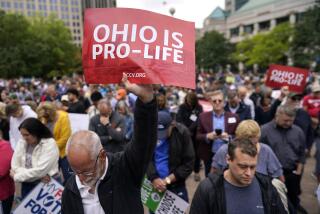Year in Review: Gay marriage dynamic in U.S. shifted dramatically in 2014

For the first time, a majority of Americans are living in a state that allows gay marriage. After a year of cascading court opinions tossing out many remaining restrictions, the dynamic in 2014 changed from how many states allow same-sex marriage to how many states don’t.
Now, at the end of the year, same-sex marriage is legally approved in 35 states and the District of Columbia, and court reviews are pending in many others.
The federal government took action as well, with Atty. Gen. Eric H. Holder Jr. extending new federal recognition to same-sex marriages in many states and announcing that same-sex spouses cannot be compelled to testify against each other and should be eligible to file jointly for bankruptcy, among other federal guarantees.
“2014 is the year that it became unquestionable that all of America will have the freedom to marry,” said Evan Wolfson, founder and president of the advocacy group Freedom to Marry. “The only question is whether 2015 will be the year that it gets done.”
For opponents, however, the battle is not over and they are looking to the U.S. Supreme Court in the coming year to make a final determination.
Four federal appellate circuits have backed same-sex marriage, but one has rejected it: the 6th Circuit, which oversees Ohio, Michigan, Kentucky and Tennessee. Cases are pending in at least four other appeals circuits, and more are expected.
“It appears now, with the 6th Circuit, the Supreme Court will take up one of these cases and decide whether to affirm states’ rights to define marriage between a man and a woman,” said Jim Campbell, a senior attorney for the Alliance Defending Freedom, which opposes same-sex marriage. “The courts are working through the question.”
The Supreme Court had a chance to take a case that would have allowed it to rule on the issue, but decided in October to give it a pass, possibly because no appeals court had yet opposed gay marriage and there were no conflicts to resolve in the lower courts.
Parties in five states have sought permission to argue the issue before the Supreme Court. The first inkling could come Jan. 9 when the court holds a conference on which cases it will take.
If the court elects to hear the same-sex marriage issue in the spring, a decision could come by June.
The legal march really started in 2013. On June 26 of that year, the Supreme Court struck down portions of the federal Defense of Marriage Act, a landmark ruling that extended federal benefits to gays and lesbians. The high court, however, stopped short of ruling that same-sex marriage was a constitutionally protected right, leaving the door open to the legal debate that has been unfolding in 2014.
In its broadest formulation, the issue pits states’ rights to decide what constitutes marriage against individuals’ rights to be treated the same regardless of sexual preferences. This was especially touchy since some of those marriage definitions involve state constitutional amendments approved by voters. Even in cases in which marriage restrictions were decided by election, courts are being asked to decide whether the majority can impose such rules on minorities.
Part of the discussion looks at how society has dealt with other kinds of marriage restrictions in the past. The most famous such restrictions were laws that barred interracial marriage. Lower court judges now frequently cite the Supreme Court’s decision to strike down such a state law in Virginia in 1967.
Utah, one of the most conservative states on the issue of gay rights, found itself in the fray over same-sex marriage when U.S. District Judge Robert J. Shelby struck down its ban on such unions on Dec. 20, 2013. The Utah case was the first in the nation in which a federal judge rejected a state ban on same-sex marriage, and was quickly followed by a similar ruling on Jan. 14 in Oklahoma.
Utah officials sought to stay the ruling, and early this year, the Supreme Court granted one. But the delay was long enough to allow more than 1,000 same-sex couples to marry.
On June 25, a panel of the Denver-based U.S. 10th Circuit Court of Appeals was forceful in backing the right for all to marry, regardless of sexual preference.
“We hold that the 14th Amendment protects the fundamental right to marry, establish a family, raise children and enjoy the full protection of a state’s marital laws,” the majority wrote in its decision. “A state may not deny the issuance of a marriage license to two persons, or refuse to recognize their marriage, based solely upon the sex of the persons in the marriage union.”
If the majority laid out what became the basis for rulings elsewhere, so did the opposition. In his dissent, Judge Paul J. Kelly Jr. warned that the court was overstepping its authority and that states should be able to decide who can marry.
“We should resist the temptation to become philosopher-kings, imposing our views under the guise of the 14th Amendment,” he wrote.
What does all this legal movement mean? There has long been debate among political scientists over whether changing social norms force the courts to rethink legal issues, or whether it is the other way around.
But in the case of same-sex marriage, both streams appear to run in the same direction.
In polls taken as recently as 1996, Americans said they opposed same-sex marriage by 68% to 27%. By 2011, a majority of Americans, 53%, said they supported same-sex marriage, according to the Gallup organization. That number had grown to 55% by May, and, perhaps more significantly for the future, 78% of those 18 to 29 years old said gay marriage should be legal.
More to Read
Start your day right
Sign up for Essential California for news, features and recommendations from the L.A. Times and beyond in your inbox six days a week.
You may occasionally receive promotional content from the Los Angeles Times.







